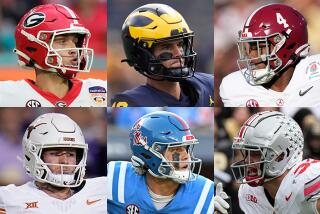A New Stat for the Bowls
On Dec. 10, in the middle of finals, our students went uncharacteristically crazy. The reason was the semifinals of the Division I-AA football playoffs and the ESPN2 telecast of the game. The College of William & Mary is not often on the nation’s athletic center stage, so everyone was excited.
Our football team accomplished two notable feats this year. First, we won 11 games, including two playoff games. Second, according to NCAA data, our football program is one of two in Division 1 with a 100% graduation rate (the other school is Duke). We are justly proud of both accomplishments.
Unfortunately, those watching ESPN2 heard only about the team’s exploits on the football field. The players’ sterling performance in the classroom was never mentioned. This leads to our modest proposal. We think that the NCAA should require broadcasters of its football games to mention the football team’s graduation rate along with the other statistics.
Other proposals on this issue would go much further. The John S. and James L. Knight Foundation recommends that eligibility for football bowl games be reserved for teams with graduation rates of at least 50%. Using this criterion, nearly half of the teams in bowls this year would not be eligible to participate. The colleges and universities whose teams would be excluded would lose a great deal of money. Last year the 28 college bowls distributed more than $185 million to NCAA schools.
We would like to see graduation rates added to the formula for the Bowl Championship Series, or BCS. Depending on the weight given to academics, differences in graduation rates might change the selection of the participants in the championship game. This year there were three undefeated contenders for the two top spots. If graduation rates were added to the mix, Auburn and USC, both with 59% graduation rates, might be squaring off for the national title, leaving out Oklahoma, with its 43% graduation rate.
The Knight Foundation proposal and altering the BCS selection criteria are radical ideas because they would change the allocation of money. For this reason, we suspect that neither has much chance of becoming NCAA policy.
Our proposal for announcing graduation rates does not affect the flow of funds. Each time the University of Oklahoma’s football team appears on TV the audience would hear about its 43% graduation rate, but Oklahoma would still earn an undiminished share of the TV revenue. Our approach relies on shame, or its opposite -- public approval -- as a powerful motivator. The trick is making the information public to everyone who matters, which in this case includes the athletes and their families as well as alumni and contributors.
The football graduation rate can’t be corrupted or tweaked by the schools since it is calculated using an NCAA formula. And football squads are large enough that averaging the last two to four years of data gives a reliable picture of the overall academic standing of the program.
The objective of college athletics should be success on the playing field and success in the classroom. At the very least, announcing the graduation rate would provide an interesting counterpoint to the promotional puff pieces the institutions craft to accompany televised games.
The NCAA likes to say each of its athletes will become a professional but that for most of them the profession won’t be athletics. That may be true for the ones who succeed academically. The task is to find a reasonable mechanism that will ensure that more of them graduate.
More to Read
Go beyond the scoreboard
Get the latest on L.A.'s teams in the daily Sports Report newsletter.
You may occasionally receive promotional content from the Los Angeles Times.










